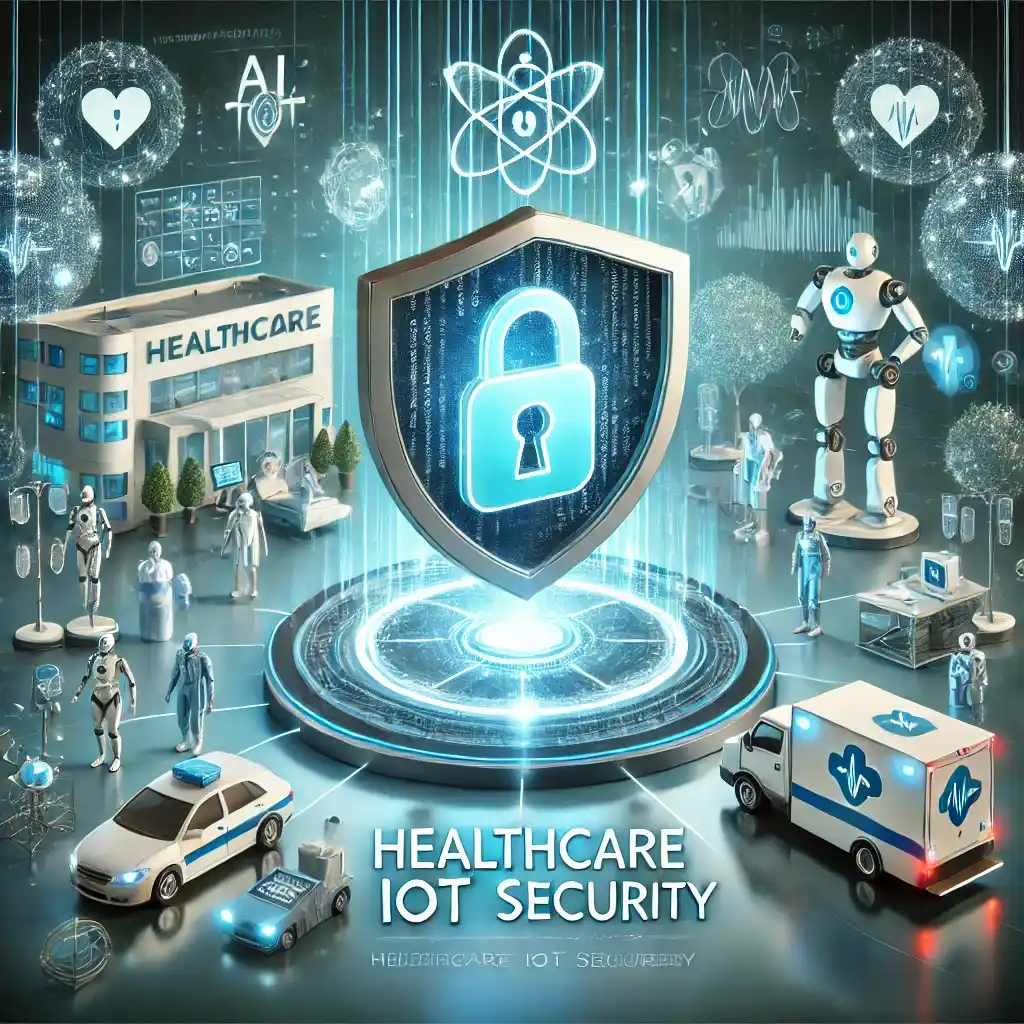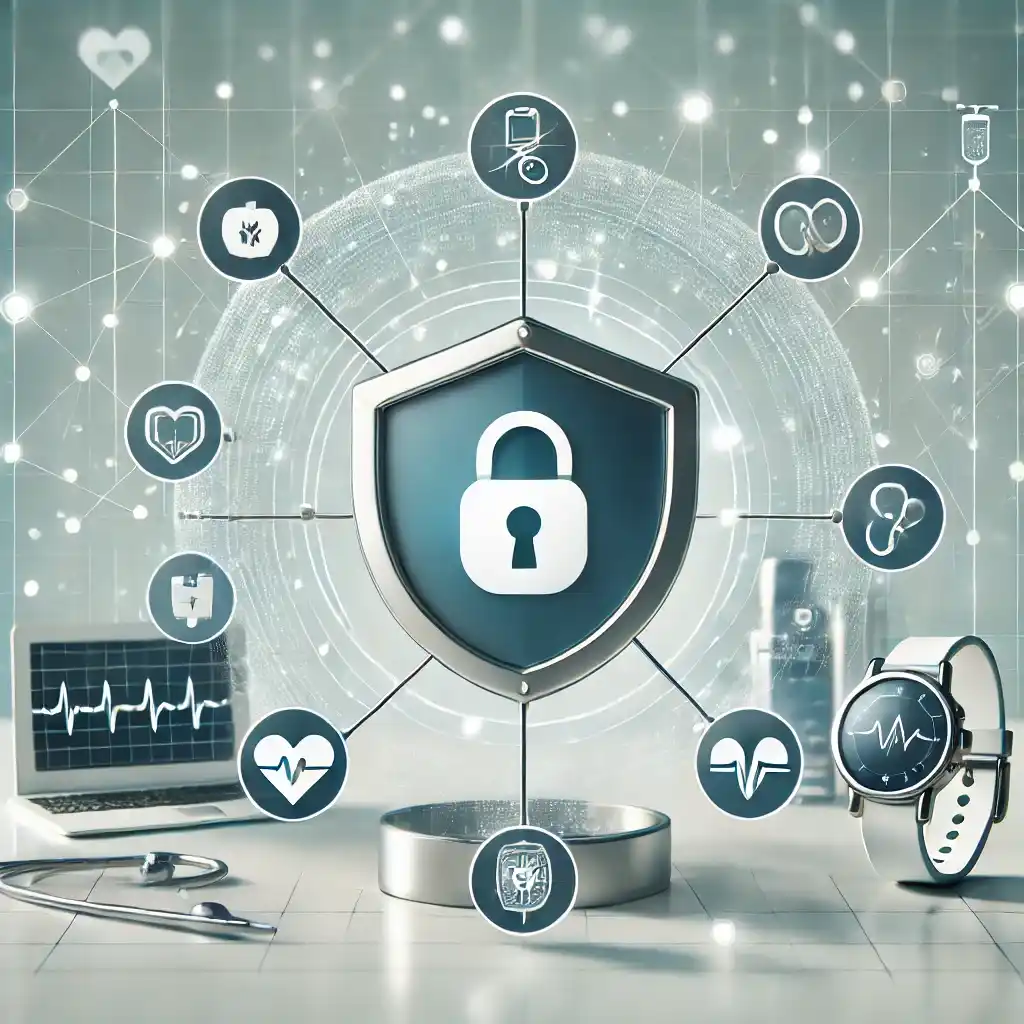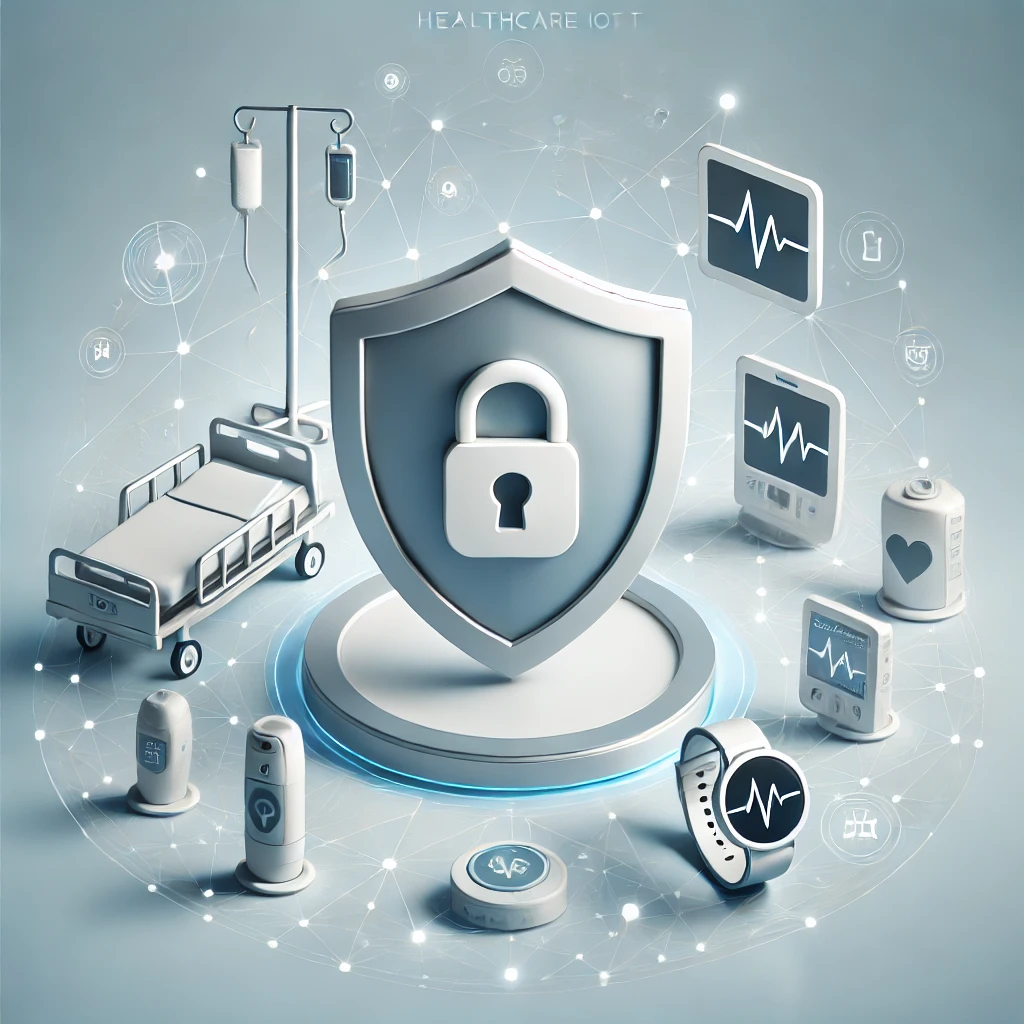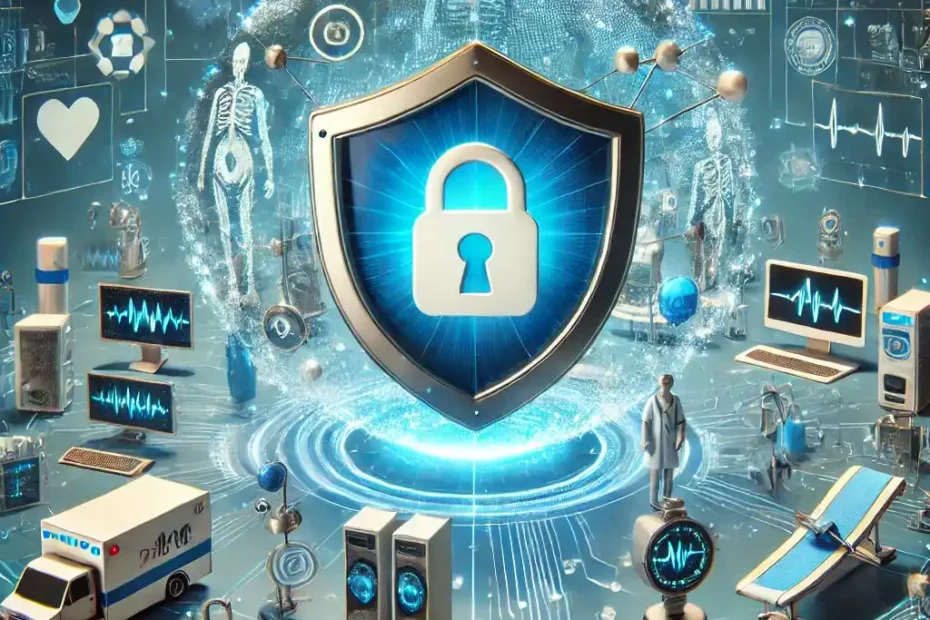1. Introduction
The Internet of Things (IoT) is revolutionizing the healthcare industry, enhancing patient care, hospital management, and medical diagnostics. With the increasing adoption of IoT in healthcare, hospitals are becoming more connected than ever, leading to improved operational efficiency and patient outcomes. However, as healthcare IoT devices become more prevalent, cybersecurity threats continue to rise. Healthcare IoT security is crucial to protecting patient data, securing medical devices, and ensuring uninterrupted healthcare services. Without proper security measures, cybercriminals can exploit vulnerabilities, leading to severe financial and reputational damages.
The integration of IoT in healthcare involves smart medical devices such as wearable fitness trackers, insulin pumps, and heart monitors, all of which collect and transmit sensitive health information. A lack of adequate security measures exposes these devices to hacking attempts, putting patient safety at risk. The evolving landscape of cyber threats demands proactive security strategies to safeguard healthcare IoT ecosystems against unauthorized access, malware infections, and data breaches. Investing in robust IoT security frameworks is now a top priority for healthcare organizations worldwide.
2. Understanding Healthcare IoT Security
What is Healthcare IoT Security?
Healthcare IoT security refers to the protection of connected medical devices, hospital networks, and patient data from cyber threats. Medical IoT devices, including wearable monitors, smart infusion pumps, and automated hospital systems, rely on network connectivity, making them vulnerable to cyberattacks. As the reliance on these devices grows, ensuring their security has become critical for maintaining patient privacy and preventing operational disruptions.
Why is Healthcare IoT Security Important?
- Real-Time Patient Monitoring: IoT enables real-time patient monitoring and remote diagnostics, allowing doctors to track vital signs and intervene in emergencies.
- Enhanced Hospital Automation: Connected devices improve hospital automation, reducing human errors and streamlining workflows.
- Protection Against Cyber Threats: Cyberattacks on medical IoT can lead to life-threatening consequences, including compromised life-support systems and tampered medication dosages.
- Compliance and Regulations: Regulatory bodies such as the FDA and HIPAA have strict guidelines for securing medical devices and patient information, making IoT security a legal necessity.
- Preventing Data Breaches: The vast amount of sensitive data collected by IoT devices makes them a prime target for hackers. Strong security measures can prevent financial and reputational damages caused by healthcare data breaches.

3. IoT Security Challenges in Healthcare
Major IoT Security Challenges in Healthcare
- Outdated Firmware and Software Vulnerabilities: Many IoT devices run on old software, making them easy targets for cybercriminals. Manufacturers often fail to provide timely updates, leaving medical devices exposed to known security threats.
- Lack of HIPAA Compliance for IoT Devices: Many IoT devices lack HIPAA compliance, putting patient privacy at risk. Healthcare providers must ensure that all connected devices adhere to data security regulations.
- Unauthorized Access and Poor Authentication Mechanisms: Weak authentication mechanisms expose hospital networks to hackers. Many medical devices rely on default passwords, making them highly susceptible to brute-force attacks.
- Body Area Network (BAN) Security Challenges: Wireless medical devices worn by patients can be hacked, leading to data breaches and health risks. Attackers can intercept signals from wearable sensors, altering vital patient information.
- Interoperability Issues: IoT devices from different manufacturers often lack standardized security protocols, leading to inconsistencies and increased vulnerabilities within hospital networks.
- Lack of Awareness and Training: Many healthcare staff are unaware of IoT security risks and fail to follow best practices, leading to accidental data breaches and exposure to malware infections.
4. Medical Device Security Risks and IoT Vulnerabilities
Common Cybersecurity Threats in Medical IoT
- Medical Device Hijacking (MedJack): Hackers exploit vulnerabilities in medical devices to gain control over hospital networks. MedJack attacks can lead to unauthorized access to medical records, device malfunctions, and ransomware infections.
- Ransomware Attacks on Hospitals: Cybercriminals encrypt patient records and demand ransom for their release. Hospitals have been frequent targets of ransomware attacks, causing severe operational disruptions and putting patient lives at risk.
- Healthcare Data Breaches: Stolen patient data is sold on the dark web, causing privacy violations and financial losses. Personal health records are valuable assets for identity theft and insurance fraud.
- Phishing and DDoS Attacks: Hackers use deceptive emails and network overload attacks to compromise healthcare systems. A single phishing attack can grant cybercriminals access to an entire hospital’s network.
- Man-in-the-Middle (MITM) Attacks: Intercepting communication between IoT devices allows hackers to manipulate or steal patient data, leading to inaccurate diagnoses and medical errors.
5. Secure Data Transmission and Patient Data Privacy
Ensuring secure data transmission and patient data privacy in healthcare IoT is essential to maintaining trust and compliance with data protection regulations. IoT devices handle sensitive medical information, making them attractive targets for cybercriminals. A single breach can expose thousands of patient records, leading to severe financial and reputational consequences for healthcare providers.
Encryption for Healthcare IoT
Encryption is a critical component of IoT security, protecting data from unauthorized access during transmission. Strong encryption protocols such as AES-256 and TLS (Transport Layer Security) ensure that medical devices communicate securely with hospital servers. Implementing end-to-end encryption (E2EE) ensures that only authorized entities can access sensitive data, minimizing the risk of interception and tampering.
In addition to encrypting data in transit, data at rest (stored data) must also be encrypted. This ensures that even if attackers gain access to databases, they cannot retrieve patient information without the necessary decryption keys. Healthcare organizations should regularly update their encryption protocols to stay ahead of emerging threats.
Cloud Security for Medical Data
Cloud computing has transformed medical data storage and sharing, offering scalability and accessibility. However, storing healthcare data in the cloud introduces new security risks. Multi-factor authentication (MFA) plays a crucial role in preventing unauthorized access to cloud-based medical records. Healthcare institutions should implement role-based access control (RBAC) to restrict data access based on user roles and responsibilities.
To further enhance security, data masking and tokenization can be used to protect sensitive patient information. Secure cloud storage providers must comply with industry standards such as HIPAA, GDPR, and ISO 27001 to ensure robust data protection.
IoT Authentication in Healthcare
Weak authentication mechanisms are a significant vulnerability in healthcare IoT security. Multi-factor authentication (MFA) requires users to verify their identity using multiple factors, such as biometrics, smart cards, or one-time passcodes. Implementing biometric authentication, such as fingerprint or facial recognition, provides an additional layer of security for healthcare professionals accessing IoT devices.
Device authentication is also crucial to prevent unauthorized IoT devices from connecting to hospital networks. Secure boot mechanisms and cryptographic certificates ensure that only verified devices can operate within the healthcare environment.
Network Segmentation for Healthcare IoT
Network segmentation enhances security by isolating IoT devices from critical hospital networks. By dividing networks into separate segments, healthcare institutions can limit the spread of cyber threats. Micro-segmentation further enhances security by enforcing strict access policies on individual devices.
Implementing firewalls and intrusion detection systems (IDS) helps monitor network traffic for suspicious activity. Regular vulnerability assessments and penetration testing can identify weaknesses in network security before attackers exploit them.

6. Protection Strategies for Healthcare IoT Security
Healthcare organizations must adopt proactive security strategies to safeguard IoT devices and patient data from cyber threats. The increasing sophistication of cyberattacks requires a multi-layered approach to IoT security.
1 Use AI in IoT Security
Artificial intelligence (AI) and machine learning (ML) are revolutionizing IoT security by detecting and mitigating cyber threats in real-time. AI-driven anomaly detection systems analyze vast amounts of network data to identify unusual patterns and potential security breaches.
AI-powered behavioral analytics can detect insider threats by monitoring user activities and flagging suspicious behavior. By automating threat detection, AI enhances security response times and reduces human intervention.
2 Employ Blockchain for Healthcare IoT Security
Blockchain technology provides a decentralized and tamper-proof method of securing patient data. Each transaction is recorded in a distributed ledger, ensuring data integrity and transparency. Smart contracts automate compliance and access control, reducing the risk of human error.
Blockchain can also be used to secure medical supply chains, preventing counterfeit drugs and ensuring the authenticity of pharmaceutical products. By leveraging blockchain, healthcare providers can improve data security, traceability, and trust in IoT networks.
3 Regulatory Compliance
Compliance with FDA cybersecurity guidelines and industry regulations is essential for securing medical IoT devices. Healthcare institutions must conduct regular compliance audits to ensure adherence to security standards such as HIPAA, GDPR, and ISO 27001.
4 Strong IoT Encryption in Healthcare
Encrypting patient records, medical images, and communications prevents unauthorized data access. End-to-end encryption (E2EE) ensures that only authorized users can view sensitive information. Regular encryption key management and secure key storage practices enhance security further.
5 Implement Zero-Trust Architecture
A Zero-Trust security model ensures that every device and user must be verified before accessing hospital networks. Trust is never assumed, and all access requests are continuously monitored. This approach reduces insider threats and prevents unauthorized lateral movement within hospital networks.
6 Risk Management for Medical IoT
Risk management involves conducting regular security assessments, penetration testing, and vulnerability scans. By identifying potential threats in advance, healthcare organizations can implement proactive security measures. Incident response plans must be in place to handle security breaches effectively.
7. Future Trends and Innovations in Healthcare IoT Security
As cyber threats evolve, so must security strategies. Emerging technologies and innovative security approaches will shape the future of healthcare IoT security.
AI and Machine Learning for Threat Detection
AI enhances security by identifying anomalies in real time, reducing the response time for cyber threats. Predictive analytics can forecast potential attacks based on historical data, enabling preemptive security measures.
AI-driven automated response systems can isolate compromised devices, preventing malware from spreading. Deep learning models enhance the accuracy of threat detection, reducing false positives.
Zero-Trust Security Models
A Zero-Trust approach eliminates implicit trust within hospital networks, requiring continuous verification of all devices and users. Adaptive authentication and micro-segmentation enhance security, preventing unauthorized access.
Zero-trust models incorporate AI-powered identity management, ensuring that access permissions are granted based on real-time risk assessments. This dynamic approach strengthens IoT security in healthcare.
Next-Gen Encryption
Advanced cryptographic techniques, such as post-quantum encryption, will further strengthen data protection. As quantum computing evolves, traditional encryption methods may become obsolete. Homomorphic encryption allows computations on encrypted data, enhancing security while maintaining functionality.
Blockchain for Medical IoT Security
Blockchain enhances data integrity, transparency, and security in healthcare IoT networks. Decentralized identity management systems powered by blockchain prevent unauthorized access to patient records. Interoperability solutions using blockchain can facilitate secure data sharing across healthcare providers.

8 Difference Between Encryption and Authentication in Healthcare IoT
| Feature | Encryption | Authentication |
|---|---|---|
| Definition | The process of encoding data to protect it from unauthorized access. | The process of verifying the identity of a user or device before granting access. |
| Purpose | Ensures data confidentiality during transmission and storage. | Ensures that only authorized users and devices access healthcare IoT networks. |
| Method | Uses cryptographic algorithms like AES-256 and TLS to scramble data. | Uses passwords, biometric authentication, and multi-factor authentication (MFA). |
| Protection Scope | Protects data from being read or altered by unauthorized entities. | Protects systems by ensuring that only legitimate users and devices can interact with IoT networks. |
| Use in Healthcare IoT | Secures patient records, cloud data, and device communication. | Prevents unauthorized access to medical devices and hospital networks. |
| Example | Encrypting patient data before storing it in the cloud. | Using fingerprint authentication to access an IoT-enabled medical system. |
9 FAQs
1. What are the biggest security risks in healthcare IoT?
Healthcare IoT faces several security risks, including ransomware attacks, medical device hijacking (MedJack), healthcare data breaches, and unauthorized access to sensitive patient information. Outdated firmware, weak authentication, and lack of encryption further expose healthcare IoT networks to cyber threats.
2. How can hospitals protect IoT devices from cyberattacks?
Hospitals can protect IoT devices by implementing strong encryption, multi-factor authentication (MFA), AI-driven threat detection, regular security updates, and network segmentation. Following regulatory guidelines like HIPAA, GDPR, and FDA cybersecurity standards also strengthens IoT security.
3. Why is encryption important in healthcare IoT?
Encryption is essential in healthcare IoT because it protects patient data during transmission and storage. Strong encryption protocols like AES-256 and TLS ensure that only authorized parties can access sensitive medical records, preventing data breaches and cyberattacks.
4. What role does blockchain play in securing healthcare IoT?
Blockchain enhances data integrity, transparency, and security by creating a tamper-proof ledger for storing patient information and medical transactions. It helps prevent unauthorized modifications and ensures secure interoperability between healthcare providers.
5. How does AI improve healthcare IoT security?
AI strengthens healthcare IoT security by detecting anomalies, predicting cyber threats, and automating threat response. AI-powered security systems analyze vast amounts of network data to identify suspicious activities, reducing the risk of cyberattacks.
10 Conclusion
The rapid growth of Healthcare IoT has revolutionized patient care, diagnostics, and hospital management. However, the increasing interconnectivity of medical devices also introduces significant cybersecurity threats that must be addressed proactively. Ransomware attacks, data breaches, and unauthorized access can compromise patient safety, disrupt hospital operations, and result in financial and reputational losses.
To ensure a secure healthcare IoT ecosystem, organizations must implement multi-layered security strategies, including strong encryption, AI-driven threat detection, blockchain technology, and compliance with regulatory standards. Additionally, network segmentation, zero-trust security models, and regular security audits play a critical role in preventing cyberattacks.
Moving forward, the healthcare industry must prioritize cybersecurity investments, foster a culture of security awareness, and adopt emerging technologies like AI and next-generation encryption to stay ahead of evolving threats. Cybersecurity in medical IoT is not optional—it is essential for ensuring patient safety, data integrity, and the overall resilience of healthcare systems.
By taking proactive security measures, hospitals and healthcare providers can strengthen their IoT security infrastructure, build patient trust, and create a safer, more efficient, and technologically advanced healthcare environment.
